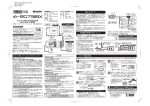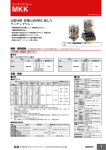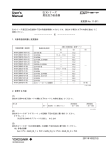Download TLS1-VOL 取扱説明書
Transcript
DMSS 2.4GHz専用 取扱説明書 TELEMETRY SENSOR SERIES 仕 様 設 置 方 法 品 番 TLS1-VOL 検出範囲 DC 0.0∼100.0V 1.センサ線を、測定したい部分に接続します。 → 振動でずれたり外れたりしないようにしっかりと固定してください。 → 振動で接続部がショートしたりしない様必ず絶縁してください。 動作電圧 4.0V ∼ 8.5V 重 量 4g 全 長 440mm(リード線長:300mm) TLS1-VOL 3.本体固定後にTLS1-VOLからのハーネスを受信機のSENS 端子 (あるいはDATA 端子 )に接続します。 → 複数のセンサを接続する場合は、Yハーネス又は、テレメトリーセンサ用アダプタを使用して接続してください。 構 成 電圧センサ TLS1-VOL このたびは、JR 製品をお買い上げいた だき、誠にありがとうございます。 本製品を正しく安全にご使用いただくために も、取扱説明書を必ずお読みください。 ※本製品はTLロゴ搭載製品専用です。 RG731BXの例 → BIND/BATT/SENS 端子 に接続してください。RG611B等は BATT/DATA 端子 に接続してください。 動力用バッテリ電圧測定例 動作確認用LED 【TLロゴについて】 JR テレメトリーシス テムに対応した製品 にのみ記載します。 2.TLS1-VOL本体を機体にしっかり固定してください。 → センサ線および本体のハーネスが引っかからないようにしっかりと固定してください。 TLS1-VOL ハーネス TLS1-VOL本体 センサ用リード線 特 徴 バインドプラグ (別売) リード線先端部を バッテリ線に接続 します。 動作確認用LED Yハーネス(別売) 動力用バッテリ端子 ・二本のリード線間の電圧差を読み取る方式で、極性はありません。 ・動力用バッテリー全体の電圧だけでなく、特定のセル間電圧 測定も可能。 ※センサリード線の接続は はんだ付けが必要です。 ケガや火傷に注意し、作業してください。 ・動作確認用のLEDを搭載し、動作確認が容易。 コネクタ拡大図 ※接続ははんだ付け加工が必要となります。 コネクタの向きに 十分注意して差し 込んでください。 製品内容 ● TLS1-VOL / センサ本体 ● 取扱説明書(本書) 安全にご使用いただくために必ずお守りください。 使用者もしくは第三者への危害・財産への損害を未然に防止する為、 必ずお守りいただくことを次のように表示します。 お守りいただく内容を、 次の表示で区分し説明します。 この表示で「注意事項」 を説明します。 この表示で「義務事項」 を説明します。 この表示で「禁止事項」 を説明します。 RG731BX受信機 (別売) 送信機での表示について ・TELEMETRYの[F-PACK V]に対応しています。 ※本センサは[F-PACK C]には対応しておりません。 電圧測定専用となります。 ※アラーム設定方法は送信機の取扱説明書をご参照下さい。 ※XG7 は対応しておりません。 配線加工方法 センサ線を電圧の測定をしたい配線に接続します。 動力用バッテリの場合配線図を参考にバッテリ側の配線を 分岐させて接続します。 下図の様にすればバッテリ側の加工無しにバッテリの素電 圧が測定できます。 動作確認および注意 定格電圧以外で使用すると、 センサの誤検出や破損の 原因となります。 2.バッテリを接続し、送受信機共電源を ON にします。 センサ用リード線接続部は必ず絶縁および防振対策を してください。 3.電源投入時はバッテリー等の電圧を検出して、初めて起動します。 ※電源起動時に発生するノイズの為、送信機に表示される 電圧値がおかしくなる場合があります。 その場合は、送信機を操作し、MAX値をクリアしてください。 飛行中は電池残量に十分注意してください。電池残量 が少ないと誤検出する場合があります。 被覆チューブやリード線にキズがついた場合は使用し ないこと。 組立後は必ず動作検査を行うこと。 分解、 改造等をしないこと。 水に濡らさないこと。 結露の生じる環境では使用しないこと。 複数のセンサを接続する場合には・・ TLS1-VOL 以外にも複数のセンサを搭載したい場合には、 TLS1-ADP の使用をご検討ください。 最大 5 種類まで同時接続できるように構成されています。 但し、同じセンサ(同種類を含む)の同時使用は出来ません。 (TL1-PWR/TL1-BVM 等は使用不可) ※ESC:エレクトリックスピードコントローラの略 TLS1-VOL 1.右図を参考にしてTLS1-VOLを接続します。 センサからのハーネスの固定も確実にしてください。ハ ーネスが絡まって事故の原因となる可能性があります。 また、ハーネスの根元が切れる可能性があります。 (別売) ・センサ線は必要な 長さにカットしご使 用下さい。 センサ線はどちらに接続 しても構いません。 4.LEDが点灯すれば正常に検出できています。 送信機の表示を確認してください。 点灯が確認できない場合は再度センサ線やハーネスの 接続を確認して下さい。 【バインドプラグは必ず抜いてご使用ください】 RG731BXなどのバインド作業にバインドプラグを必要とする 受信機の場合、バインド終了後にバインドプラグを抜かなけ れば双方向通信のデータは送信機上に表示されません。 バインドプラグは必ず抜いてご使用ください。 レギュレーター ・ ESC 等 ※振動で接続部が外れたり、 ショート したりしない様、 熱収縮チューブ等で 必ず絶縁及び防振対策をしてくださ い。 注意 はんだゴテでのケガや火傷に十分注意してください。 ■ 修理、 アフターサービスに関するお問い合わせ 【日本遠隔制御株式会社 ラジコンサービス課】 お問い合せ TEL:06(6732)0200 受付時間/9:00∼13:00・14:00∼17:30(土・日・祝日及び当社休日を除く) http://www.jrpropo.com 修理・アフターサービス・製品に関するお問い合わせ等に関する情報をご案内しています。 日本遠隔制御株式会社 〒577-0809 東大阪市永和2-2-12 NEM-C94A Specifications Operation Manual Installation Method 1. Attach the sensor wires to the electric power source wires - polarity does not matter. !"#"""#" Note:Be sure to attach the wires securely, by carefully soldering the connections. Be sure to use heat shrink tube or insulation tape to avoid short circuits. $%#"&#' 2. Be certain to securely mount the sensor to the aircraft. Weight: 4g Length: 440mm (sensor wire length: 300mm) TELEMETRY SENSOR SERIES TLS1-VOL Note: X=8?8==:8===8==8<#9V8=$W slot available on the receiver, connect the battery connection to the empty slot, and connect the sensor communications harness to the “SENS” or “DATA” slot. = Configuration Thank you for purchasing this JR product. To allow correct and safe use of this product, be certain to read this operation manual. *This product is exclusively for use with products that incorporate the TL logo. +-/01!56$7!8090:5 TLS1-VOL [About the TL Logo] This logo is only included on products that support the JR Telemetry System communications). Note: Be sure that none of the wires or connectors contact the moving components. 3. After fixation of the TLS1-VOL to the aircraft, connect the sensor communications harness to the receiver’s “SENS” or “DATA” port. LED For the RG608<=>80AATA terminal TLS1-VOL connection example to the main power battery pack. TLS1-VOL Main Unit TLS1-VOL Sensor wire ・ The sensor can be used to measure total voltage, ?@== (Sold separately) or the voltage of a single cell. ・Because the unit measures voltage difference, there is no polarity requirement for the sensor lead. ・The LED indicates voltage measurement is taking place. *Note that the sensor lead must be soldered to your point of measurement. Be careful soldering - always have the battery unplugged and remember the soldering iron is hot. Be sure to check the polarity before installation. For your safety, be sure to observe the following points In order to protect against injury to users or third parties, or damage to property, please observe the following. The information is divided and explained using the following symbols. “Caution Items” are explained using this indication. Transmittor Operation ・Telemetry type: Flight pack voltage [F-PACK V] *This sensor dose not record capacity, it only reads voltage. *To set a voltage alarm in the transmitter, please refer to the transmitter instruction manual. *Note the XG7 does not support telemetry. Wiring To measure main power pack voltage, solder the sensor lead to the objective lines as shown in the figure below. Using this method, your battery pack does not need to be modified. If the product is used with a voltage other than the rated voltage, it will cause misdetection or damage to the sensor. Be sure to securely fix the sensor. In the situation where the sensor comes into contact due to the influence of vibration, damage will be caused. Be sure also to securely fix the harness coming from the sensor. If the harness becomes tangled, it may cause an accident. Further, the base of the harness may be cut. Pay adequate attention to the remaining battery amount during flights. If the remaining battery amount becomes low, there may be cases where incorrect readings occur. Do not use any component which has been damaged, included wires or connectors. To ensure that the sensor is functioning as desired, please test accordingly. Do not fly until check is complete. Do not disassemble or modify this product. Do not get the product wet or damage may be caused. Do not use the product in environments where condensation occurs. Operation Confirmation and Cautions TLS1-VOL *The sensor leads can be shortened as necessary. # Refer to the drawing on the right to connect the unit. 2. After the TLS1-VOL is connected to the receiver (if necessary, using a TLS1-ADP or a Y-harness), turn on the power to the receiver. 3. The sensor will activate automatically. Note: Occasionally noise generated by the motor may cause a high maximum voltage to be recorded - simply reset (clear) the maximum value on the transmitter to obtain correct values. 4. If the LED glows, the voltage is being sensed correctly. Please check the transmitter indications. If the LED does not glow, check the wire connections including the sensor communications harness. IMPORTANT: Be sure to remove the bind plug prior to use. H8<==8=8+-/01+&/0K88Q plug, be sure to remove the bind plug from the receiver prior to use as it V=K88=>W will not be displayed on the LCD screen. (Sold separately) Electric Motor Notes: 1. When you are using a 2s LiPo and regulator to supply your receiver, you may use the TLS1-VOL to measure true receiver battery voltage (indicated as F-PACK-V on the transmitter). The TLS1-VOL can be wired into the switch harness before the regulator. 2. An alternative method of connecting the TLS1-VOL to your battery is to plug it into your LiPo balance connector (measuring either single cell or whole pack voltage). “Obligatory Items” are explained using this indication. “Prohibited Items” are explained using this indication. Main battery connector (Sold separately) +-/01< (Sold separately) Sensor Main Unit Operation Manual (this document) (Sold separately) Close up of the connector * The sensor wire must be soldered to the battery leads or terminals. Product Contents Main battery LED Bind Plug (Sold separately) Features Solder the sensor lead to the battery connector s positive pole and negative pole. Note: Polarity of the sensor wires is not important. Note: Polarity of the sensor wires is not important. Regulator, ESC , etc.. Note: Be sure to insulate the sensor leads with heat shrink tube or insulation tape to avoid short circuits, or the solder joints breaking with vibration. Caution Be careful handling the soldering iron. 3.When multiple sensors are to be connected... When you wish to incorporate several sensors in addition to the TLS1-VOL, please use the optional the TLS1-ADP. This adaptor is configured to allow simultaneous connection of up to five sensor types. However, it is not possible to use more than one of the same sensor type at the same time. ■ For further questions or inquiries please contact your local dealer or JR distributor in your country. http://www.jrpropo.com



![UA20-MLT7取扱説明書ダウンロード [日本語PDF 512KB]](http://vs1.manualzilla.com/store/data/006609887_2-9e95ed1ac952d6f2ac56c73ed7373123-150x150.png)





